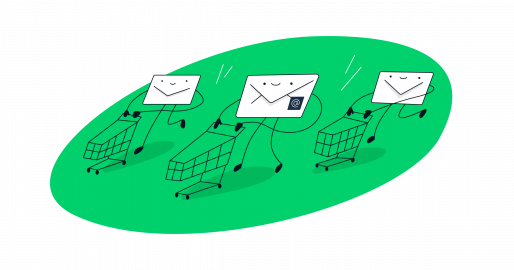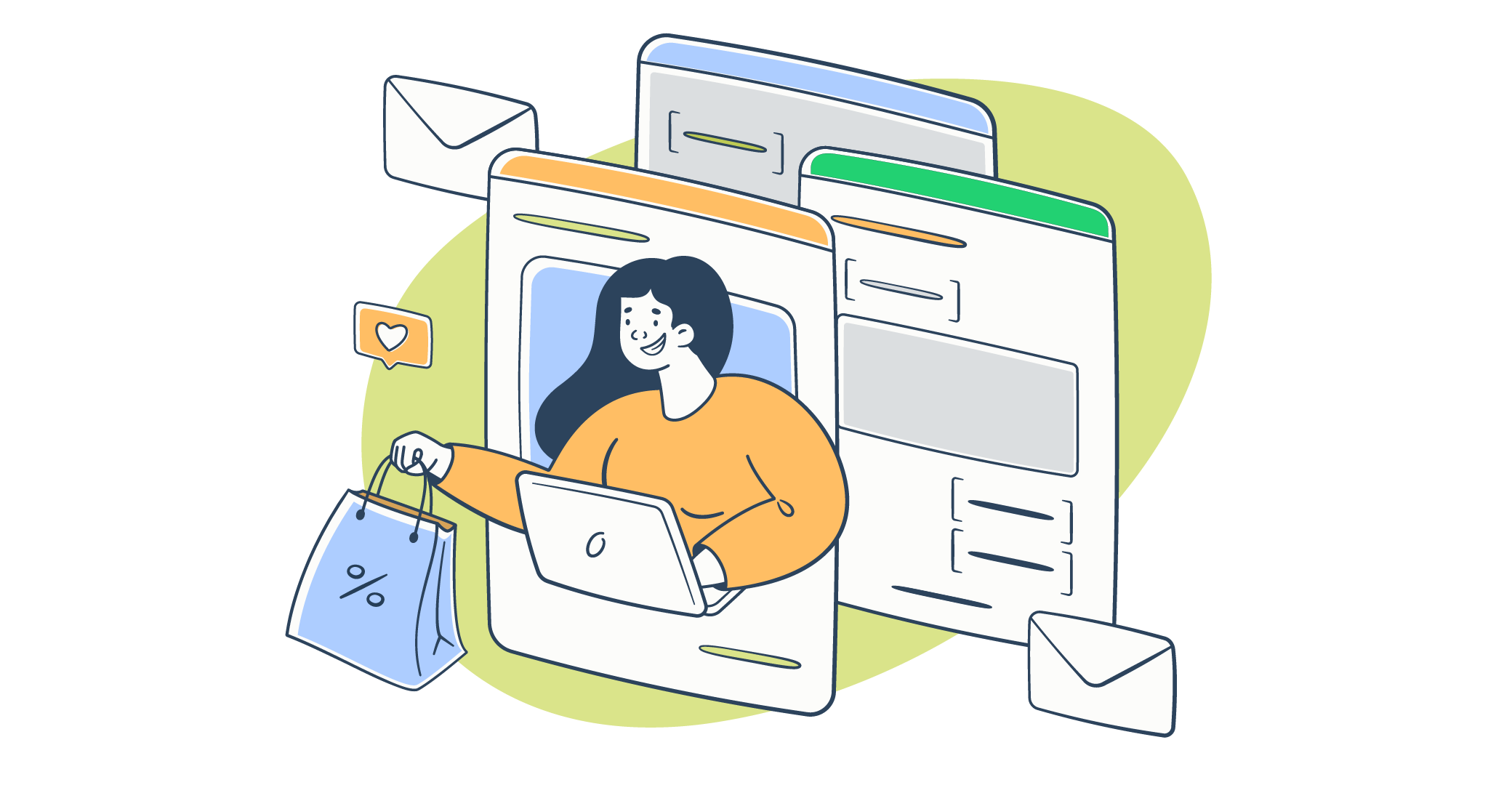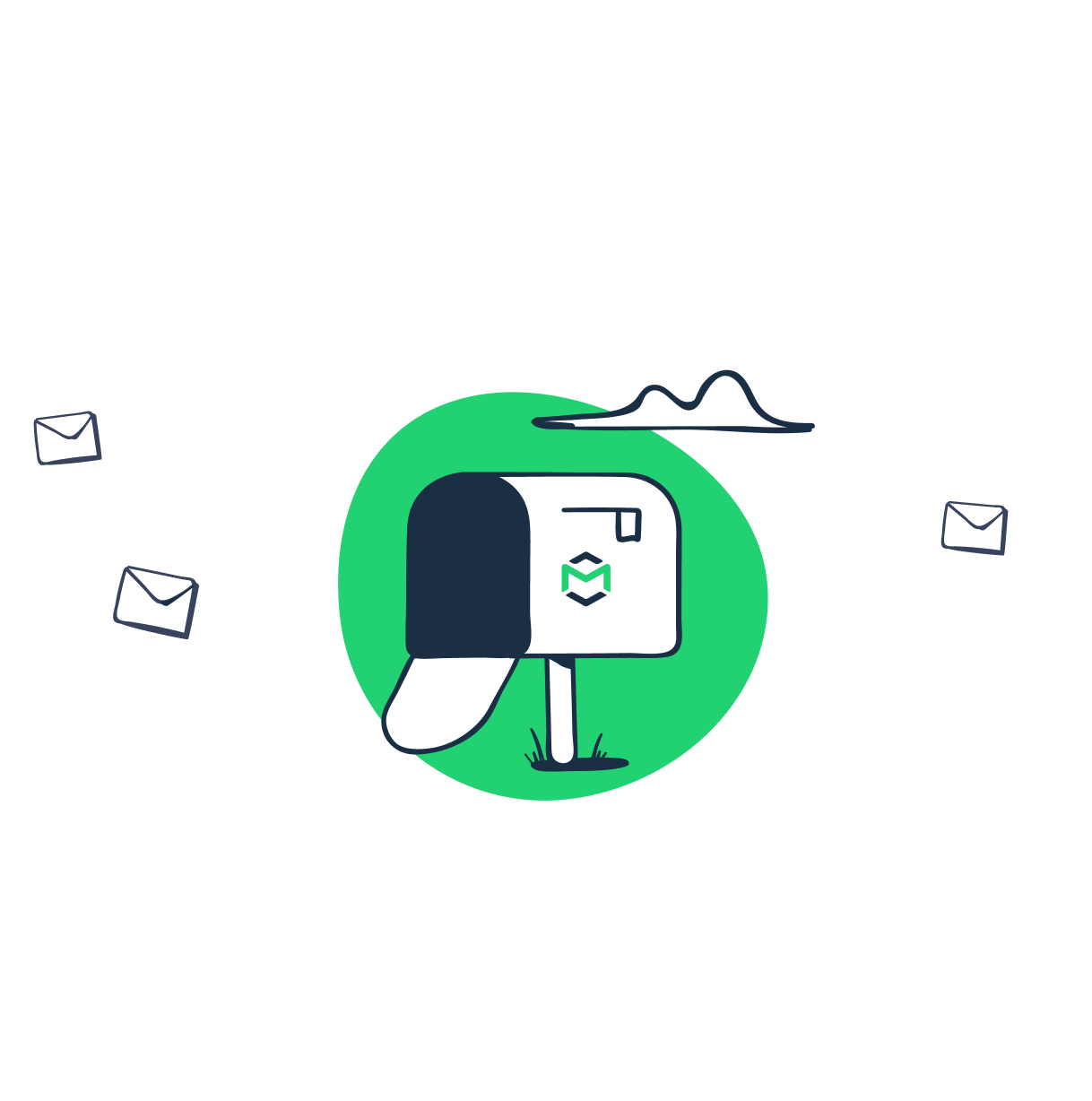During my time in marketing, I’ve collaborated with all sorts of teams and created campaigns targeted at different audiences. And when it comes to achieving goals like engaging customers, driving repeat purchases, and, most importantly, boosting revenue, I still found email marketing to be extremely powerful.
So, in this article, I’ll teach you all the fundamentals of e-commerce email marketing including real-world email examples, email marketing tips, and the best tools for the job.
What is e-commerce email marketing?
E-commerce email marketing is the use of emails to promote, engage, and drive sales for e-commerce online stores, especially through targeted email marketing that responds to customer behavior and preferences.
In a typical e-commerce email marketing campaign, you’ll likely encounter promotional offers, reminders, recommendations, and other targeted types of emails, which are also found in different industries.
But what makes e-commerce email marketing truly unique is the way it taps into real-time shopping behavior to create personalized experiences.
For example:
- Abandoned cart emails remind shoppers of items they left behind, often with a nudge like a discount.
- Product recommendation emails suggest items based on what someone just viewed or purchased, making them a great way to cross-sell
- Post-purchase follow-ups might ask for a review and even suggest related products.
These small, automated touches feel personal, and they work.
E-commerce email marketing types (with examples)
E-commerce email marketing includes a variety of campaigns tailored to each stage of the customer journey. Below, I’ll highlight a few core types with real-world email marketing examples to show how they drive results.
Welcome email: Glossier
Welcome emails are usually the first touchpoint after potential customers subscribe – they set the tone for the brand and invite the customer in. They’re also a chance to say hello, share the gist of your brand, and guide new email subscribers on what to do next.
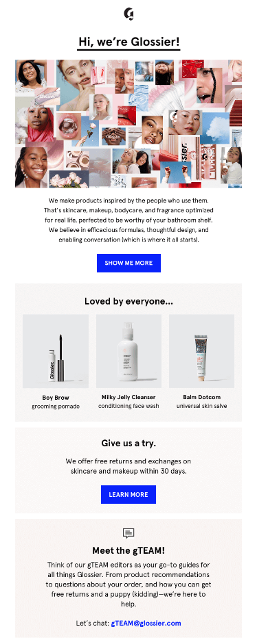
This welcome email from Glossier is clean, easy on the eyes, and packed with a few clear calls to action to help you start exploring right away.
Its main goal? To give new subscribers a feel for what Glossier’s all about – their products, their vibe, and their community. More specifically, the email aims to:
- Give a quick intro to Glossier’s philosophy and product lineup
- Tempt first-time purchases by showing off bestsellers
- Build trust with things like free returns and solid customer support
- Get people engaged through social media and a bit of brand storytelling
When it comes to the structure, we can divide it into:
- Brand intro – Starts with a friendly “Hi, we’re Glossier!” and a collage of real people using their products, instantly setting a warm, inclusive vibe. A quick intro explains the brand’s mission, with a CTA: “Show Me More”.
- Best-sellers and social proof – Highlights fan favorites like Boy Brow and Milky Jelly Cleanser under “Loved by everyone…” – subtle, effective social proof.
- No-risk shopping – Mentions free returns and exchanges to ease hesitation.
- Customer support – Introduces the friendly support team with a contact email, which makes reaching out easy and personal.
- Community stories – Features real user stories under “Beauty inspired by real life”.
- In-store vibes – Invites subscribers to visit Glossier showrooms.
- Social media – Encourages following on Instagram for more inspo.
- Playful wrap-up – Ends with a fun note: “Fun stuff. And it’s free!”.
All in all, this welcome email checks all the right boxes. It smoothly walks new subscribers through who Glossier are, what they offer, and how to get involved, whether that’s making a purchase, exploring more content, or following along on social.
Cart abandonment email: Ugmonk
Cart abandonment emails are follow-up messages sent when someone adds items to their shopping cart but leaves without buying. They’re a gentle nudge to come back and complete the purchase.
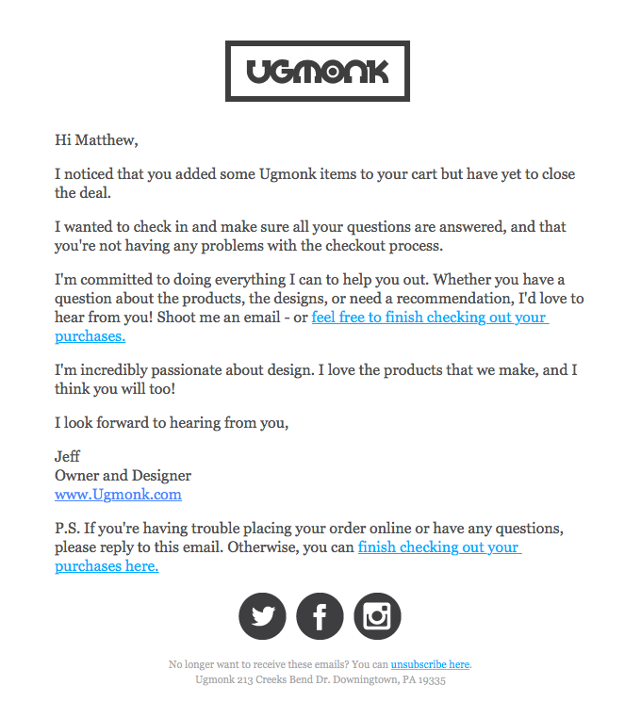
This email from Ugmonk is a great example. It feels personal and helpful – more like a friendly note from the founder than an automated reminder. It’s brand-driven, warm, and keeps the experience feeling human.
What’s it trying to do? Bring shoppers back and encourage them to finish what they started – their purchase. But there’s more to it than that. It’s also designed to:
- Ease any doubts or checkout issues that may have held them back
- Build trust by keeping the tone friendly and personal
- Remind them of the brand’s passion and product quality to spark that final click
For the structure, Ugmonk decided to go with:
- Personal touch – Kicks off with a friendly “Hi Matthew,” which instantly makes the email feel more human. It casually points out that the customer left some items in their cart – just enough of a nudge without any pressure.
- Friendly check-in – Instead of pushing a sale, the message simply asks if there were any issues at checkout and offers help. It keeps the tone light and helpful, lowering any friction.
- Brand vibe – The founder shares a bit of his passion for design and the products, adding a personal layer that builds trust and excitement.
- Gentle nudge – Includes a clear but laid-back CTA to finish the purchase, linked right in the sentence. No hard sell – just an easy path back to the cart.
- Extra support – A P.S. adds a final touch, inviting the customer to reply directly if they have questions. There’s also another CTA link, just in case they missed the first.
- Stay connected – Social icons at the bottom encourage customers to follow the brand on other platforms, and an unsubscribe link is included to keep things transparent.
All in all, this abandoned cart email strikes the right balance. It gently reminds the customer about their cart, offers support if needed, and keeps the tone warm and personal. With a clear CTA and a touch of brand personality, coming back to complete the purchase feels easy and inviting, not pushy.
Re-engagement email: Prima
Re-engagement or win-back emails are sent to regain subscribers who haven’t interacted with a brand in a while. They’re a chance to reignite interest and remind people why they signed up in the first place.
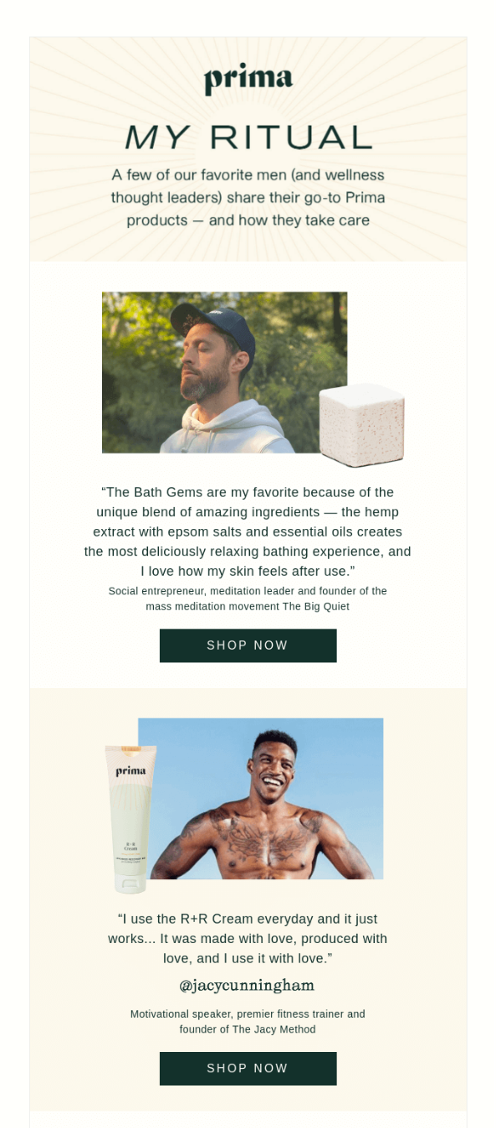
This email from Prima does just that, but with a twist. Instead of the usual “We miss you!” approach, they keep things fresh by using social proof and personalized product recommendations to draw people back in.
What’s the goal here? Prima’s trying to reconnect with subscribers who’ve gone quiet and spark some fresh interest in their new products. But it’s not just about grabbing attention – it also aims to:
- Gently remind people what the brand’s all about
- Build trust with testimonials and influencer shoutouts
- Drive action with easy “Shop Now” buttons
- Highlight new stuff, like digital gift cards, to re-spark curiosity
In terms of structure, Prima decided on:
- Wellness vibes up front – The email opens with “MY RITUAL”, instantly setting a calm, self-care tone that fits Prima’s brand. A quick intro highlights real people (wellness influencers) sharing how they use Prima in their daily routines.
- Real voices, real impact – Instead of just listing products, Prima shares genuine testimonials from trusted voices in the wellness space. Each quote comes with a product, a personal story, and who’s behind it, adding authenticity and credibility.
- Plenty of ways to shop – Every section includes a “Shop Now” button, giving readers an easy way to take action without feeling overwhelmed. The CTAs are spaced out naturally, so they’re helpful and not pushy.
- Something new to try (or gift) – For those not ready to buy for themselves, Prima introduces digital gift cards as a thoughtful alternative. A “Send One Now” button makes it simple to share the love.
- Wrapping it up with options – The footer keeps things clean, with social links to Instagram and Spotify for more ways to connect with the brand. And, of course, there’s a visible unsubscribe link to keep things transparent and user-friendly.
Overall, this re-engagement email does a great job of sparking interest without coming on too strong. By blending real-life stories, trusted voices, and subtle nudges, Prima makes it easy for subscribers to reconnect with the brand.
The well-placed CTAs and intro of gift cards give readers a few different ways to jump back in, whether they’re shopping for themselves or someone else.
Promotional email: MOO
Promotional emails are all about driving sales, usually by highlighting special offers, normal and VIP discounts, or limited-time deals. They’re designed to grab attention and get people clicking fast.
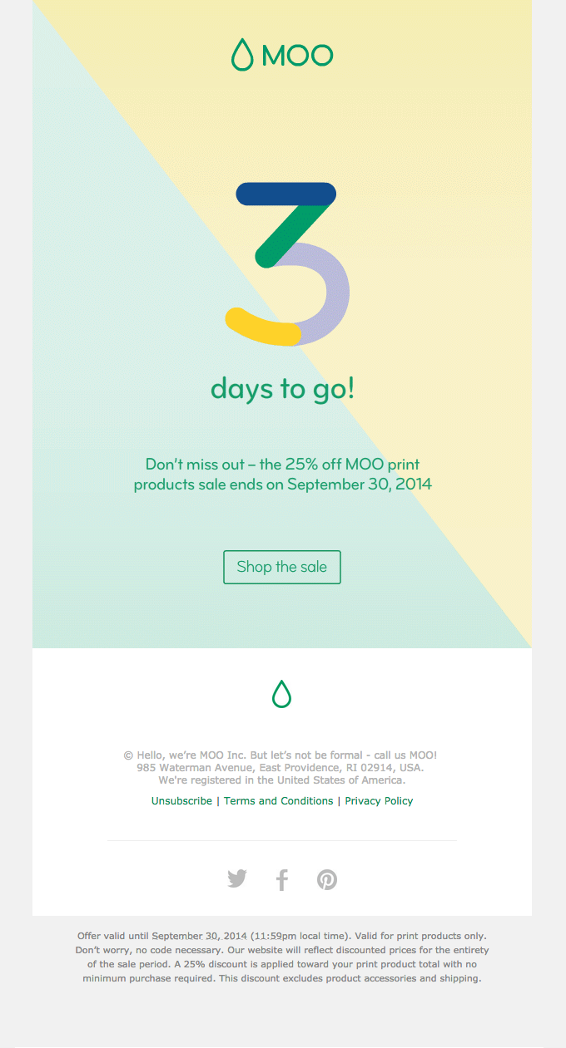
This promo email from MOO is a great example. The design’s super clean and easy on the eyes, with clear messaging and just the right amount of urgency to nudge you to act before the deal’s gone.
So, what’s the goal here? Simple: get people to jump on a 25% off coupon before it’s gone. But that’s not all – it’s also meant to:
- Add a little urgency with a “3 days to go!” countdown
- Make it super easy to shop with a clear, no-fuss CTA
- Quickly explain the deal so there’s no confusion about what you’re getting
Here’s how MOO structured things:
- Urgency right up front – The email kicks off with a bold, colorful “3 days to go!” visual that immediately grabs your attention. It sets the tone and reminds you that the clock’s ticking on this deal.
- Short and sharp messaging – The sale announcement gets straight to the point: 25% off print products until September 30th. No fluff – just the info you need to act fast.
- Easy-to-spot CTA – A clear “Shop the sale” button is front and center. The contrast makes it pop, so there’s zero confusion about what to do next.
- Friendly footer vibes – MOO keeps things approachable with a casual intro (“Call us MOO!”) alongside the logo. It also covers all the essentials – terms, conditions, social links, and an easy unsubscribe option.
- No surprises – The fine print at the bottom clearly explains the deal: what’s included, what’s not, and when it ends. It’s all about clarity and keeping the checkout process smooth.
This promo email nails it when it comes to creating urgency without overcomplicating things. The countdown grabs attention right away, the message is short and clear, and the CTA makes it super easy to jump in.
With its clean layout and no-frills approach, it keeps the spotlight on the deal and makes acting on it feel effortless.
Benefits of e-commerce email marketing
Email marketing benefits are something I’ve experienced firsthand. From having direct access to your customers to boosting that sweet sweet ROI, email marketing can do a lot for an eCommerce business, and I’ll tell you all about what I’ve seen in my experience.
However, I do need to stress that email marketing is not a magic switch.
To really get results, you’ll need to invest in proper tools, stay on top of deliverability, run consistent A/B tests, and be ready to play the long game – one that requires a budget, patience, and strategy.
And if you’re thinking of doing things on a smaller scale, email marketing should still technically work. But if you’re just starting out, I’d honestly explore a few other channels first, such as organic social, influencer shoutouts, or even running a few low-budget paid ads.
High ROI
With its $36 to $40 average ROI, email marketing is one of the most cost-effective channels in e-commerce because it speaks directly to existing customers and others already familiar with your brand, such as past buyers, subscribers, or cart abandoners. These audiences are more likely to convert because the trust barrier is lower, reducing the cost per acquisition.
Unlike paid ads that constantly chase new leads, email lets you re-engage warm leads at almost no cost per message. What amplifies the ROI further is automation and email segmentation. Using them, you can send personalized content like product recommendations or discount codes based on a customer’s behavior, which increases the likelihood of repeat purchases.
This combination of low spend, high personalization, and strong intent makes email uniquely profitable in the e-commerce space.
Complementary marketing channel
Email marketing isn’t just another channel – it’s a powerful way to reinforce your broader marketing strategy.
For example, someone might click a paid ad, land on your ecommerce website, and see a pop-up offering 10% off their first order in exchange for their email. Even if they don’t complete a purchase right away, you’ve now captured their email, allowing you to follow up later with a discount code or a reminder.
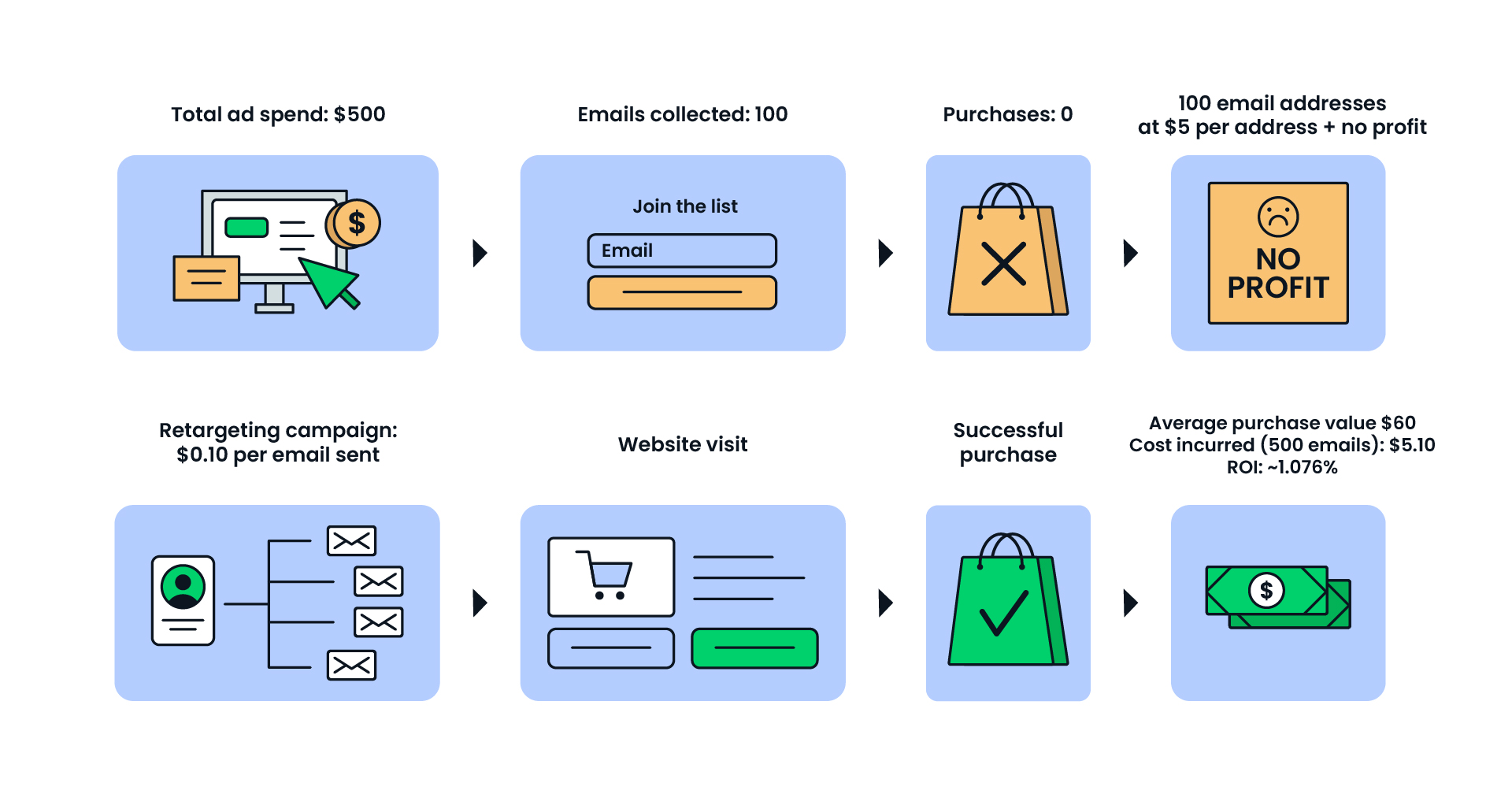
Or if your social media campaigns build awareness, email can nurture that interest by sending product recommendations, reviews, or exclusive content to those who opted in.
Email can also support post-event engagement. So, if someone signs up for a webinar or in-person event, you can automatically follow up with a thank-you message that includes a replay link, next steps, or a product trial..
By syncing email with your other efforts, and making sure to collect emails along the way, you ensure no touchpoint is wasted and that your brand stays top-of-mind across platforms.
Access to and ownership of unique data
Owning your email list means you don’t just have access to your audience; you own the behavioral data that comes with it.
Unlike social media, where algorithms limit visibility, email gives you complete control and visibility into who engages and how. This includes open rates, click patterns, purchase history, and browsing behavior you can track and use to build smarter, more personalized campaigns.
For example, you might set up a win-back flow for customers who haven’t purchased in 60 days, trigger a follow-up email when someone views one of your product pages but doesn’t buy, or offer early access to high-value customers. And these aren’t just good ideas; they are strategies that work.
According to ConvertCart, cart abandonment emails average a 45% open rate and recover up to 10.7% of lost sales, while TargetBay claims that welcome and post-purchase email flows also consistently outperform bulk sends, driving better engagement and more revenue.
You can also A/B test subject lines by customer segment, then roll out the best-performing version to the rest of your list. Over time, this lets you build a smarter, more responsive strategy based on real customer behavior – no middlemen required.
Plus, when you grow your list organically and follow GDPR, along with sender requirements from Gmail, Outlook, and Yahoo, your emails are more likely to reach the inbox, not the spam folder, keeping you in full control of deliverability and reach.
Direct communication
Email gives you a rare advantage: a direct, unfiltered line to your customer’s inbox. This matters because it puts you in full control of the message, timing, and frequency, without needing to rely on algorithms, ad budgets, or third-party platforms.
For example, if you’re launching a flash sale, you can immediately notify your most engaged buyers and drive traffic within minutes. You can also set up automated flows, like welcome sequences or loyalty campaigns, that guide customers through a personalized journey without interruption.
This kind of consistent, one-on-one communication helps you build trust, increase engagement, and ultimately drive more repeat purchases.
Below, you can see a comparison between the email and social ads marketing channels.
| Social ads | Email campaign | |
| Time to reach audience | ~12 hours (ad review & ramp-up) | Instant delivery |
| Visitors arrived | 130 | 230 |
| Conversion rate | 9.2% (Brafton avg.) | 0.3% (Klaviyo avg.) |
| Spend | $500 (ad spend + creative) | $50 (platform + setup time) |
Disclaimer: This table is a simplified, illustrative example based on current benchmark data. Actual results vary depending on audience quality, creative, and campaign setup.
How to do e-commerce email marketing
Looking at all the benefits e-commerce email marketing brings, it’s only natural to think, “What does it take to implement it?”. And the answer is a multi-step process.
This process takes time, testing, and ongoing effort. Think of it as you do about SEO – it’s a strategic investment, which brings great results but with time.
So, if you’re a small business owner working at a smaller scale, results from email marketing may come more slowly, and that’s okay. That said, it’s important to experiment and stay open to the idea that other channels might deliver better results depending on your audience and resources.
Let me now walk you through the process of running email marketing and cover all the steps, from coming up with the right email marketing strategy to optimizing the results.
Create an e-commerce email marketing strategy
If you’re new to this, the idea of an “e-commerce email marketing strategy” might sound a bit overwhelming, but don’t worry. It’s not as complicated as it seems, and I’ll break it down step by step, with real examples to help you get started.
You see, a well-thought-out strategy helps turn casual subscribers into loyal customers and keeps your messaging aligned with your business goals.
So, how do you actually set those goals? A good place to start is by deciding what you want your email marketing to accomplish, whether that’s increasing repeat purchases, boosting your average order value, or reducing cart abandonment.
To make sure your goals are clear and actionable, you can use the SMART framework:
- Specific: Be clear about what you’re trying to achieve (e.g. increase repeat purchases).
- Measurable: Define how you’ll track success (e.g. 15% increase in customers buying more than once within 30 days).
- Achievable: Make sure the goal is realistic given your audience size and resources.
- Relevant: Align it with your overall business goals (e.g. improving customer retention).
- Time-bound: Set a deadline (e.g. within the next 3 months).
For example, instead of saying “I want to improve sales”, a SMART goal might be: “Increase revenue from email sequence by 20% over the next quarter by focusing on upsell and product recommendation flows”. This helps you stay focused and gives you a clear target to build your strategy around.
Do keep in mind that once you launch an email campaign, your results might look different from your initial expectations, and that’s completely normal, as great email marketing comes from testing, tweaking, and improving your strategy over time.
Build a quality email list
When it comes to email marketing, your mailing list is everything, and quality always beats quantity. A small, engaged list will consistently outperform a large one full of unresponsive contacts.
Of course, building that kind of list takes time and effort, but it’s the foundation of any successful email strategy. So, where do you start?
First and foremost: never buy email lists. It might seem like a quick win, but it almost always backfires, leading to spam complaints, low engagement, and damage to your sender reputation. Instead, focus on building an organic list made up of people who actually want to hear from you.
To do that, you’ll need a steady stream of relevant inbound traffic. SEO is a dependable long-term strategy, but it’s not the only option. Channels like a well-promoted social media profile, an engaged YouTube or TikTok audience, or any platform where you’re actively building trust and visibility can work just as well.
Once you have traffic, give visitors a reason to subscribe – whether through pop-ups, embedded forms, or dedicated landing pages offering something valuable in return – a discount, early access to new products, loyalty program perks, or even a giveaway. Use signup forms at key points: during checkout, in exit-intent pop-ups, or promoted across your social channels.
Whether it’s a “Get 10% off” banner or a simple “Be the first to know” in your site footer, every opt-in counts.
Pick the right email marketing software
The success of your email marketing efforts doesn’t just depend on how you send and what you send – it also depends on what you’re sending it with. Choosing the right email marketing platform is key to making sure your messages actually reach inboxes, not spam folders.
With so many email marketing tools and email service providers (ESPs) out there, it’s easy to feel overwhelmed, especially if you’re just starting out. You’ll find tons of platform reviews, side-by-side comparisons, and strong opinions online. But I believe that the best platform is the one that fits your needs, your budget, and your workflow. Reviews should just be there to help you navigate your way to finding that platform.
So, start by testing a few options, reading the user reviews, and seeing which platform feels right for how you like to work.
To help you narrow down the list of choices, here’s a simple checklist of things to look for:
- Deliverability: Does the platform have a strong reputation for inbox placement and getting emails past spam filters?
- Features: Can it handle automation, segmentation, personalization, A/B testing, and generate analytics?
- Integrations: Does it easily connect with your e-commerce platform (like Shopify or WooCommerce) and other tools you rely on?
- Customer testimonials: What are real users saying, especially businesses similar to yours?
- Ease of use: Is the interface intuitive, with tools like drag-and-drop editors to save you time?
- Scalability: Will it still meet your needs as your business and list grow?
If you’re an e-commerce brand sending a high volume of emails, and deliverability is a top priority, this is where a platform like Mailtrap could be a great fit. It’s built for companies that care about sending at scale, hitting inboxes consistently, and having the analytics to track all important deliverability metrics.
Among Mailtrap’s growth-focused features, you’ll find auto warm-up, dedicated IPs, throttling, and more aimed at allowing you to deliver user-triggered, mass, and marketing emails to inboxes even during seasonal email volume spikes.
On top of that, within Mailtrap, you can also test your emails prior to sending and make sure they won’t trigger spam filters, contain no HTML/CSS issues, and look good on all screen sizes.
Definitely one to try out during your selection process!.
Our team has tested plenty of the best email marketing software and covered their performance in depth in the following listicles:
- Email Deliverability Comparison Results
- 6 Best Email Marketing Platforms
- 7 Best Free Email Marketing Platforms
- 6 Best Cheap Email Marketing Platforms
Prepare email content and start sending
Your email content, whether you’re sending email newsletters, product announcements, or promotions, is a direct reflection of your brand, and every message you send should offer something meaningful, whether that’s a limited-time deal, a product tip, or a new arrival worth checking out.
Focus on what matters to your customers and keep it relevant, visually engaging, and easy to skim. Personal touches like using names or referencing past purchases go a long way, and trust-builders like customer reviews or UGC help boost credibility.
Finally, don’t forget to test and tweak elements like subject lines, CTAs, and visuals so your emails keep improving with every send. You never know – a spam word could have crept its way in or a new alternative might just resonate better with your audience.
Track, analyze, and optimize results
Every campaign you send is a chance to learn what’s working and what’s not.
Are people opening your emails? Clicking through? Actually, buying something? Email marketing metrics like open rates, click-through rates, and conversion rates tell you where you’re hitting the mark and where you need to tweak.
A/B testing different subject lines, CTAs, layouts, or send times can uncover small changes that make a big difference. And when you optimize based on those insights, you’re not just guessing; you’re building a smarter, more effective email strategy that grows with your business.
How to send an e-commerce email marketing campaign
So you feel ready to launch an e-commerce campaign? Great! With most quality software solutions, this step is a straightforward one. Below, I’ll take you through all the steps to send an email campaign with Mailtrap.
To start the campaign creation process, you’ll first have to sign up for a free Mailtrap account via Google, GitHub, Office 365 account, or your email.
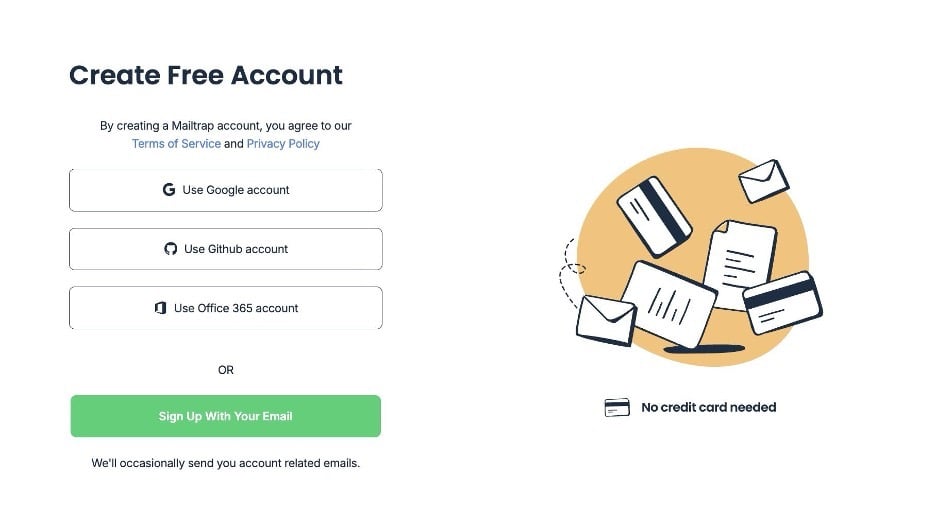
Then, you should add and verify your domain so that sending becomes enabled for you.
This process is described in detail in the Mailtrap help center.
With a verified domain, you can proceed and upload your contacts to Mailtrap.
Upon upload, your contacts can be added to new and existing lists or segments, which you can then use as the target audience for your campaign.
After your contacts have been uploaded and added to an appropriate list, go ahead and Navigate to Email Marketing -> Create New Campaign.
Here, you’ll first be asked to enter some basic details like the domain, campaign name, subject, from name, from email, and reply-to name and reply-to email.

Then comes the campaign designing step.
In Mailtrap, designing an email campaign can be done with only a few clicks using the drag-and-drop mechanism or by writing some code for the HTML editor.
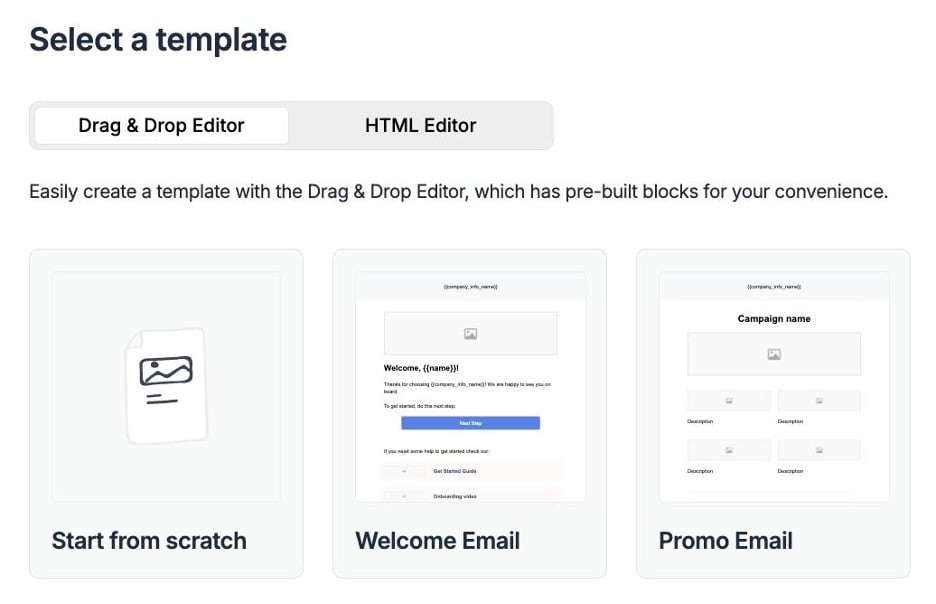
Along with these two tools, Mailtrap users also get access to a free image library, AI image generation, AI recommendations for catchy copies, and much more for creating their email campaigns, with all of it located in the Mailtrap dashboard under Email Marketing -> Create New Campaign -> Edit Campaign or Templates -> Create New Template.
As the last step before sending off your campaign, you’ll have to select an audience by including at least one list or segment.

With all of these steps complete, simply click Schedule Campaign and either send your message immediately or choose an appropriate date and time.
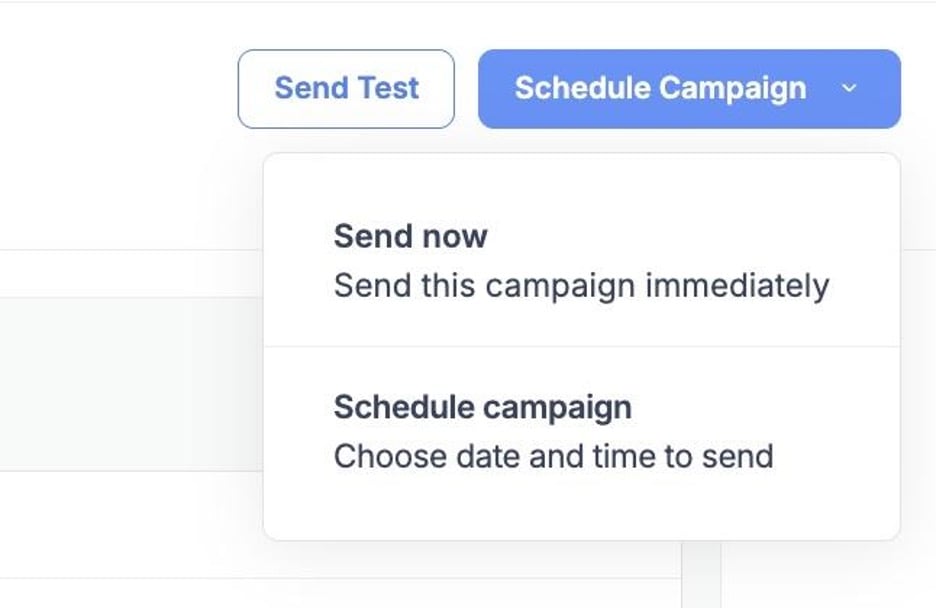
How much does e-commerce email marketing cost
The cost of e-commerce email marketing can vary widely based on your list size, how often you’re sending, and whether you’re using advanced features like automation or segmentation.
The good news? You can start small. Most platforms offer affordable entry plans, and as your business grows, you can scale your investment accordingly.
When planning your e-commerce email marketing budget, there are a few factors you’ll need to consider. These factors include:
- Pricing model: Most platforms base their pricing on the size of your email list, number of sends per month, and access to advanced features like segmentation, automation, and detailed analytics. Make sure the cost aligns with your current list size and projected growth.
- Labor (in-house or outsourced): Running email campaigns involves strategy, copywriting, design, and technical setup. You may handle this in-house or hire freelancers or agencies. In-house teams mean salaries; freelancers and agencies charge per hour or per project.
- CRM and e-commerce integrations: If you’re connecting email to your store, CRM, or analytics platform, you may need plugins, middleware, or custom development, all of which can impact budget.
- Compliance and privacy: Staying compliant with GDPR, CAN-SPAM, and other data regulations might require specific tools for consent tracking, double opt-in, and secure storage, which is especially important if you serve global markets.
- Scalability and team setup: As your business grows, your email marketing needs will too. So, start by identifying who will manage your campaigns now – yourself, a freelancer, or a team – and plan for how that might evolve. Bigger goals often require more specialized support, which means higher costs down the line.
- Training and onboarding: If you or your team are new to email marketing, factor in the cost (or time) of training. This might include online courses, certifications, or onboarding sessions from the software provider.
Now, for the actual costs you should expect to pay:
| Contacts / Email Volume | Business Type | Monthly Cost (DIY) | Monthly Cost (Agency-managed) |
| Up to 1,000 contacts | New or solo seller | $0–$30 | $200–$1,000 |
| Up to 25,000 contacts | Small store / growing brand | $50–$300 | $750–$2,500 |
| Up to 100,000 contacts | Mid-sized e-commerce business | $500–$1,500 | $2,000–$6,000 |
| 100,000–500,000+ contacts | Large or high-volume brand | $1,500–$3,000+ | $5,000–$15,000+ |
Note: These are rough estimates based on 2024 pricing from leading email platforms and typical freelancer or agency rates. DIY costs reflect software only, while agency-managed costs include outside help. Actual pricing will vary depending on your list size, features, and how much support you need.
Best software for e-commerce email marketing
Earlier, I walked you through what to look at when picking email marketing software – deliverability, features, integrations, testimonials, ease of use, scalability, and so on. Based on those factors, I’ll now introduce you to three platforms I think are especially great for getting started with e-commerce email marketing:
But, before we jump into any recommendations, a quick heads-up: while platforms like Shopify and WooCommerce do offer built-in email tools, they often fall short when it comes to advanced features, automation, and long-term scalability. That’s why I won’t be covering them this time around.
Mailtrap
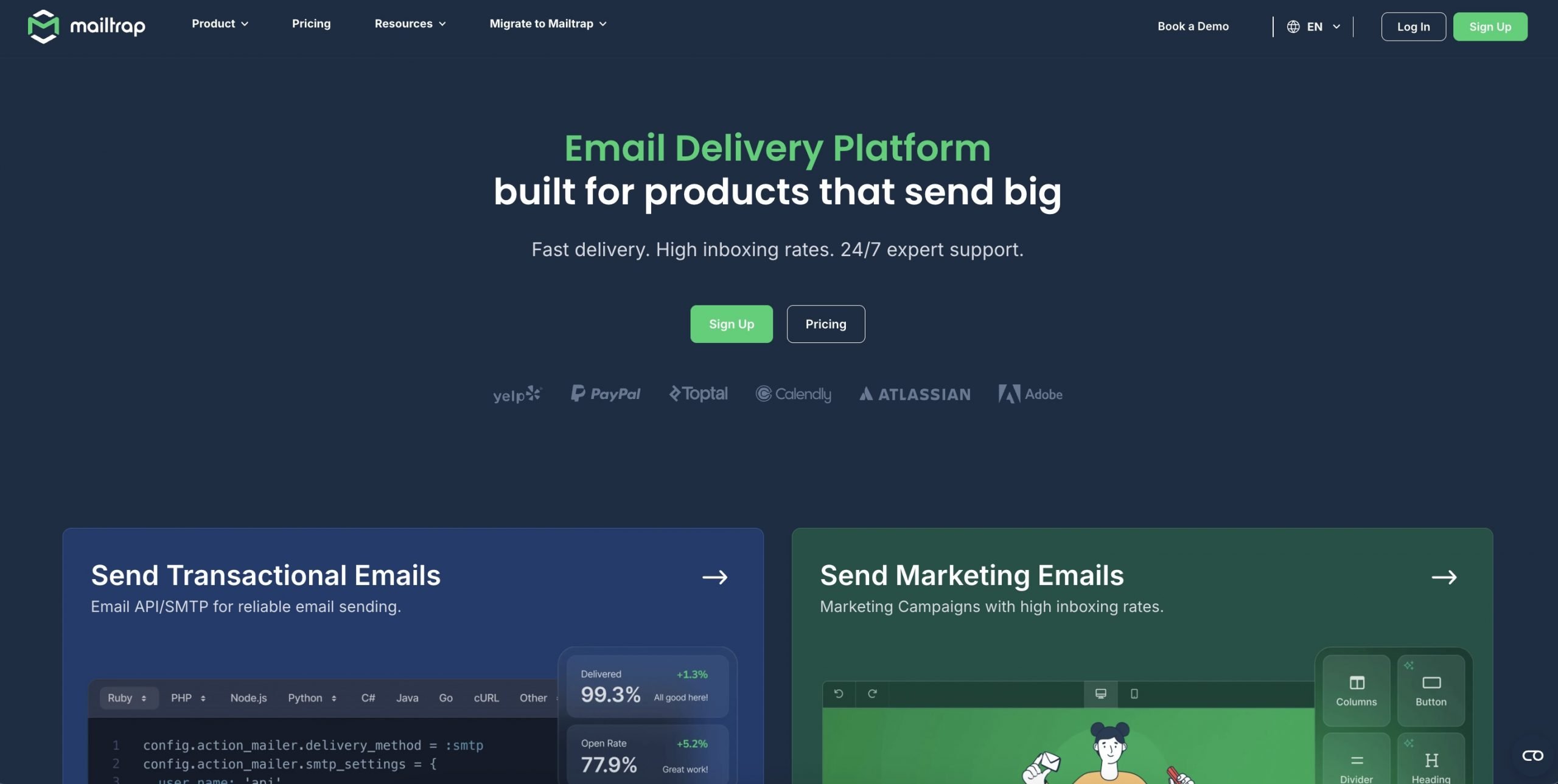
Mailtrap is an email delivery platform designed for companies with high-volume email sending. It provides customers with high email deliverability, industry-best analytics, and growth-focused features.
It is great for dev, and marketing teams to send marketing, bulk, and transactional emails. And with Its Email Testing tool you can also make sure your message looks great inboxes and doesn’t trigger email spam filters.
In terms of email marketing tools offered by the platform, these include:
- Drag and drop email builder
- Email marketing templates editor
- Intuitive contacts management
- AI content assistance
- And more
For businesses with large-scale email needs, Mailtrap has the Business plan starting at $85 per month for 100k emails and 100k contacts. This flexible plan can support up to 750k emails and contacts monthly and provides the best “value for money” for e-commerce businesses.
It includes features such as auto warm-up, dedicated IPs, and throttling for sending high volumes with no risk to deliverability, along with detailed email logs and actionable analytics for tracking performance.
Klavyio
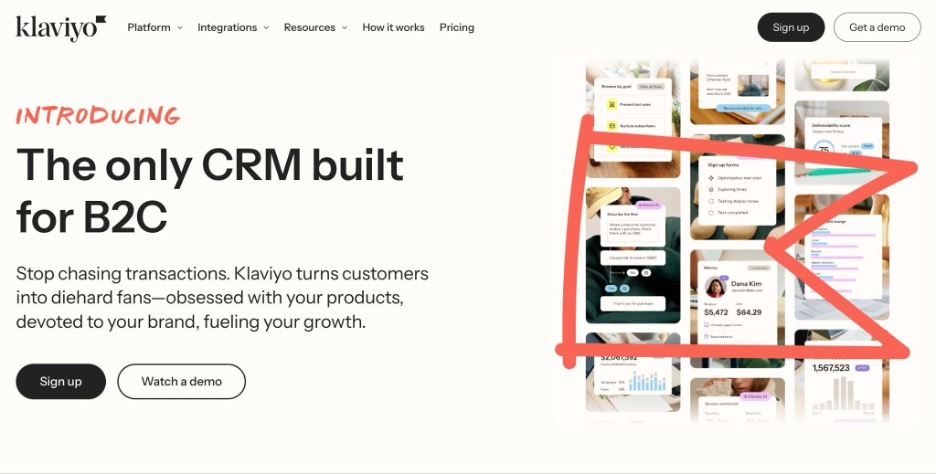
Klaviyo is an email marketing platform with integrations for platforms like Shopify, WooCommerce, and BigCommerce. It offers segmentation, automated workflows, and personalized messaging, helping e-commerce stores boost engagement and drive more sales.
With its drag-and-drop editor and HTML support, Klaviyo enables you to create dynamic campaigns while its AI-driven segmentation and predictive analytics ensure the right message reaches the right customer at the right time.
Klaviyo offers a free plan for up to 150 contacts and 500 monthly email sends. Paid plans start at $20 per month for up to 5,000 email sends, making it a strong choice for e-commerce businesses looking to scale with data-driven automation.
Omnisend
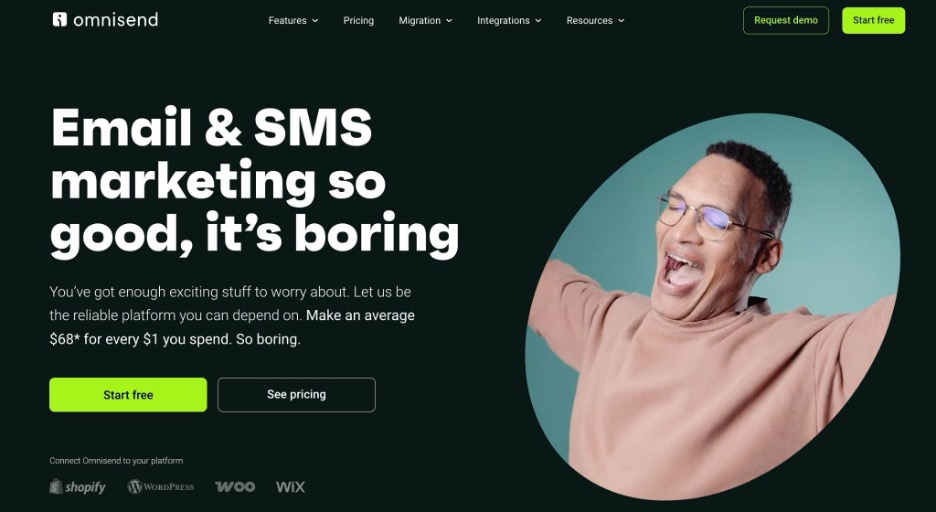
Omnisend is an all-in-one email and SMS marketing platform. With a drag-and-drop editor, customizable email templates, and advanced segmentation, businesses can easily use it to send personalized emails, SMS, and push notifications based on shopping behavior. Omnisend also includes pre-built automation workflows for things like abandoned cart recovery messages, order confirmation emails, and post-purchase follow-ups.
Omnisend offers a free plan with 500 emails per month for up to 250 contacts. Paid plans start at $16 per month for 3,000 emails and scale as your business grows, making it a smart choice for e-commerce brands looking to unify their marketing across multiple channels.
E-commerce email marketing best practices and tips
Email marketing takes ongoing effort as it’s not a “set and forget” type of activity. Here are a few best practices to keep improving your results.
Maintain email list hygiene
A clean email list isn’t optional, it’s critical for hitting the inbox and keeping your sender reputation intact. To maintain it, regularly remove inactive subscribers who haven’t engaged in 60 to 90 days, especially after sending a re-engagement campaign.
Use email verification tools to prevent fake or mistyped addresses from slipping in and damaging your deliverability. Watch your bounce rates and spam complaints closely. And avoid sending email blasts to everyone on your list.
Use personalization and segmentation
Personalization is all about sending the right message to the right person at the right time. So, start by segmenting your list into meaningful groups, like cart abandoners, repeat buyers, or people who only shop one product category, not just demographics like age, location, or gender.
Then, tailor your messaging to those groups with dynamic content and relevant offers. If someone browses a product but doesn’t purchase, follow up with a reminder that includes that product and a few related suggestions.
The goal is to make every email feel like it was written for that specific customer, because the more relevant it is, the more it converts.
Use automation to scale
Smart marketing automation allows you to create personalized experiences without having to manually set up every campaign. So use it to create essential flows like welcome sequences, abandoned cart recovery, back in stock alerts, post-purchase follow-ups, and win-back emails for customers who haven’t returned.
These flows run in the background, responding to customer behavior in real time and keeping your brand top-of-mind. Just be sure to review them regularly to improve subject lines, timing, and messaging based on what the data shows.
Optimize for mobile
With most emails being opened on smartphones, mobile-first design should be your default. So, keep your layout simple, use a single column, and make sure text is readable without zooming in.
CTA buttons should be large enough to tap easily, and placed near the top so they’re visible immediately.
Subject lines need to be concise, ideally under 40 characters, to avoid getting cut off in mobile previews. Also, compress your images so they load quickly for slower mobile connections.
Ensure compliance and easy unsubscribing
Being a commercial email sender means following privacy laws like GDPR, CAN-SPAM, and CASL by collecting clear consent and keeping records of when and how each subscriber opted in.
Along with following this best practice, always include a visible unsubscribe link, and don’t make people jump through hoops to opt out. Lastly, avoid “noreply” email addresses and use a recognizable sender name to build trust.
Wrapping up
Mastering email marketing for e-commerce as a retailer isn’t about following a fixed formula. It’s about understanding your old and new customers, testing strategies, and fine-tuning your approach over time.
Only this way will you be able to create strategies that will bring more repeat customers and higher e-commerce sales, as well as have your brand stay top of mind.
So, whether you’re just getting started or looking to refine your e-commerce email marketing approach, use this tutorial as your guide to staying on the right track.
Also, don’t forget to check out our YouTube channel and related blog posts:
- Email Marketing Funnel Explained [with Examples]
- Mass Email Marketing in 2024: Dead? Alive? Find Out Here!
- Email Blast: What Is It and How to Send One [With Examples]
- Cold Email Marketing: Definition, Importance, and Guidelines
- Email Infrastructure: The Definitive Guide [2024]
- What Is Email Feedback Loop and Why Is It Important?

